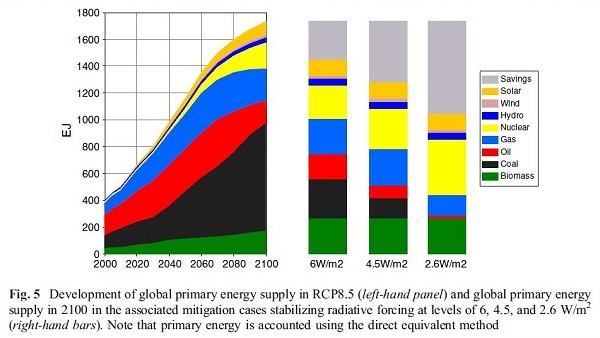Dramatic Estimates of Future Heat-Related Deaths Hype, Not Fact

 The Natural Resources Defense Council (NRDC) last month released Killer Heat: Paris Agreement Compliance Could Avert Hundreds of Thousands of Needless Deaths in America’s Cities. The report is unabashedly part of the campaign to reverse President Trump’s decision to withdraw from the Paris Climate Agreement.
The Natural Resources Defense Council (NRDC) last month released Killer Heat: Paris Agreement Compliance Could Avert Hundreds of Thousands of Needless Deaths in America’s Cities. The report is unabashedly part of the campaign to reverse President Trump’s decision to withdraw from the Paris Climate Agreement.
Killer Heat claims that “implementation of the Paris Agreement could reduce total summertime deaths by about 12,820 per year from 2091 to 2100, amounting to more than 128,000 fewer excess deaths over the period.” In other words, if Trump makes good on his decision to withdraw from the Paris Agreement, he will be responsible for killing 128,000 Americans in the century’s final decade and many thousands before that.
Are Killer Heat’s mortality estimates solid? No. Killer Heat’s conclusions depend on questionable assumptions about climate sensitivity, the “business as usual” emissions trajectory of the global economy, and the Paris Agreement’s impact on global emissions. The results also hinge on the unrealistic notion that U.S. urban populations will not adapt to more frequent and severe hot weather. In fact, they already do.
Assumption: Climate Sensitivity Is 3°C
Two speculative quantities chiefly determine global warming estimates: total net radiative forcing from anthropogenic emissions and climate sensitivity. Let’s examine climate sensitivity first.
Climate sensitivity is the equilibrium (long-term) temperature increase from a doubling of atmospheric carbon dioxide equivalent (CO2e) greenhouse gas concentrations. Climate sensitivity is a speculative quantity because the relative strength of the feedbacks, positive and negative, that amplify or damp down the direct heating effects of anthropogenic greenhouse gas emissions is largely unknown.
Killer Heat does not discuss climate sensitivity but it cites Climate Action Tracker (CAT) as the source of its warming projections for both the “no-action” and “Paris Agreement” scenarios. CAT’s warming projections, in turn, are based on the MAGICC climate model’s median climate sensitivity estimate of 3°C.
As it happens, several recent observational studies indicate that a doubling of greenhouse gas concentrations will increase global temperatures less than 3°C above pre-industrial levels. The average of those studies is about 2°C, or one-third less than the sensitivity estimate on which NRDC apparently relies to project future warming and heat-related health impacts.

Scientists have been trying to determine climate sensitivity for decades, and a vigorous debate continues. Nonetheless, a balanced study would not only alert readers to the pivotal role of climate sensitivity estimates in climate change impact assessments, but also compare heat-related mortality projections under both the 3°C median sensitivity typical of modeling studies and a lower estimate based on newer empirically-based research.
Assumption: High-End Emissions Scenario Is Business As Usual
The other key quantity in any global warming forecast is a projection of total greenhouse gas emissions, concentrations, and associated radiative forcing over a particular time period. Such projections are called “Representative Concentration Pathways” (RCPs).
RCPs are “pathways” because they plot the trajectory of greenhouse gas emissions and concentrations, and the resulting changes in radiative forcing, over a period of decades to centuries, usually from pre-industrial times to 2100 and beyond.
“Radiative forcing” may be defined as the difference between the amount of solar energy absorbed by the Earth and the amount radiated back to space. Forcing is expressed in watts per square meter (W/m2). Accordingly, RCPs are identified by their respective W/m2 forcing. The IPCC’s 2013 Fifth Assessment Report (AR5) uses four RCPs to project future global temperatures: RCP8.5, RCP6, RCP4.5, and RCP2.6.
RCPs are “representative” because several socio-economic development scenarios in the literature have similar forcing characteristics.
Killer Heat purports to compare U.S. heat-related mortality under two emission trajectories: “no action” and “Paris Agreement.” In the no-action pathway, unconstrained GHG emissions exert a forcing of 8.5W/m2 by 2100, raising global temperatures 4.1-4.5°C above preindustrial levels. In the Paris Agreement pathway, constrained emissions exert a forcing of 4.5W/m2, raising global temperatures 2.3-2.9°C above preindustrial levels.
However, the proposition that RCP8.5 represents “business-as-usual” is highly dubious, as Blair King explains on his “Chemist in Langley” blog.
Quoting van Nuuren et al. (2011), an authoritative RCP overview study, King notes that RCP8.5 “leads to a forcing level near the 90th percentile for baseline [no policy action] scenarios.” In other words, RCP8.5 projects more GHG forcing in 2100 than about 90 percent of all baseline scenarios in the literature.
Unlike the emission scenarios used in the IPCC’s 2007 Fourth Assessment Report (AR4), RCPs do not assume a specific socio-economic development path. The purpose of RPCs is to enable climate modelers to work from a standardized set of forcing trajectories, not to derive those trajectories from alternative “story lines” of future socio-economic development. Nonetheless, RCP developers cannot avoid offering some socio-economic narrative, or else the “pathway” has no plausibility.
RCP8.5 was originally based on an AR4 story line called A2 developed by Keywan Riahi and colleagues in 2007. The U.S. shale revolution was then in its infancy. So we can sum up what’s wrong with RCP8.5 in two words: Natural gas. Thanks to the fracking revolution, the world is on its way to substituting gas for coal for electrical generation, which will reduce prospective net emissions from power generation (about a third of the total) not only by displacing coal but also by backstopping intermittent renewables. RPC8.5 does not incorporate the shale gale.
According to Riahi et al. (2011), the A2 “story line” contains the following elements:
- Coal use increases almost 10-fold by 2100 and there is a continued reliance on oil in the transportation sector.
- Population increases continuously (does not peak) in the 21st century, resulting in a global population of 12 billion by 2100.
- Per capita income growth is slow and both internationally as well as regionally there is only little convergence between high and low income countries.
- Because economic development is slow, there is little progress in energy efficiency. Combined with the high population growth, that leads to rapid energy demand growth.
- Despite high energy demand, international trade in energy and technology is limited and overall rates of technological progress are modest.
- Reflecting the slow rate of technological change, the long-term reduction in the energy-intensity of production slows to 0.5 percent annually—well below the historical average of roughly 1 percent annually during 1940-2000.
- High population growth combined with slow improvements in energy efficiency and non-fossil energy technologies lead to a tripling of energy demand, met primarily by fossil fuels.

Source: Riahi et al. (2011). RCP8.5 projects coal consumption to increase almost ten-fold during 2000-2100 (graph on left).
King comments: “Looking at what the activists have labelled the ‘Business as Usual’ scenario we see a slew of assumptions that are anything but business as usual.”
A real-world business-as-usual baseline would reflect the following information:
- In the UN’s mid-range population growth projection, global population levels off at 10 billion in 2100, it does not keep growing past 12 billion, as in A2.
- “Rather than trade blocs hoarding technologies, we are living in an increasingly international world where technological improvements move at the speed of the internet and new and improved renewable energy technologies are both being developed and shared worldwide,” King observes.
- The decline in energy intensity is not slowing down. For example, the U.S. Energy Information Administration (EIA) projects that during 2012-2040, energy intensity will decline by 1.4 percent annually in OECD countries and 2.2 percent annually in non-OECD countries (International Energy Outlook 2016, p. 147).
- EIA projects a 17 percent increase in global coal consumption during 2012-2040 (International Energy Outlook 2016, p. 61). That’s not nothing, but in RCP8.5 coal consumption during 2012-2040 increases about three times as much.
- Green energy advocates claim renewables are already cheaper than fossil fuels in many markets. To my knowledge, none claims coal is poised to surge after 2040.
Every part of the A2 storyline that would make RCP8.5 a plausible baseline is itself either implausible or sheer conjecture. Using RCP8.5 as a baseline inflates warming projections and associated heat-mortality impacts.
Assumption: Paris Will Take Big Bites out of Warming
As noted, Killer Heat claims full implementation of the Paris Agreement will reduce future warming from 4.1-4.8°C to 2.3-2.9°C. Again, NRDC’s source appears to be Climate Action Tracker. However, according to CAT, policies already in place prior to the Paris Agreement’s “nationally determined contribution” (NDC) emission-reduction pledges will reduce warming from 4.1-4.8°C to 3.3-3.9°C. Yet NRDC gives the impression that, absent the Paris Agreement, global temperatures will rise by 4.1-4.8°C.
In other words, based on the CAT analysis, Killer Heat overestimates future warming absent the Paris Agreement by about 24 percent.
In CAT’s breakdown of emission trajectories and global temperatures, current policies plus the Paris commitments limit global warming to 2.5-2.8°C. That’s similar to Killer Heat’s estimate that the “Paris Agreement scenario” will limit warming to 2.3-2.9°C. Killer Heat does not explain the small discrepancy, but let that pass.
![]()
More critical is whether the Paris Agreement would in fact take big bites out of future warming—hence effectively mitigate any associated heat-related mortality.
In a peer-reviewed study published in November 2015, environmental researcher Bjørn Lomborg, using the same MAGICC model as Climate Action Tracker, finds that if every country fulfills its Paris NDC by 2030, “the total temperature reduction will be 0.048°C (0.086°F) by 2100.” Moreover, even if the promises are extended for another 70 years and there is no emissions backsliding, “the entirety of the Paris promises will reduce temperature rises by just 0.17°C (0.306°F) by 2100.”
Thus, even if we assume the world will warm as much as NRDC projects under the “no action” scenario, the Paris Agreement will barely put a dent in either global warming or the associated heat-mortality effects.
Assumption: Human Adaptive Capabilities Will Not Keep Pace with Warming
In an appendix on methodology, Killer Heat acknowledges that “we did not consider possible behavioral changes of local populations (e.g., increased use of air-conditioning) or physiological acclimatization.” Elsewhere it calls air-conditioning “lifesaving,” links the availability of air conditioning to household income, cites a finding that less than 50 percent of households in Los Angeles have air-conditioning, and notes that in Chicago “911 calls for heat-related emergencies tend to increase when the temperature gets above 95 degrees Fahrenheit, but in Phoenix the threshold is 113 degrees Fahrenheit.”
Tellingly, Killer Heat declines to estimate the heat mortality effects of global warming for six metropolitan areas (Charlotte, NC; Columbus, OH; Houston, TX; Miami, FL; San Diego, CA; and Tampa, FL). Why? Because the researchers “did not find statistically significant relationships between dangerous summer days and excess deaths” in those locales.
What those remarks suggest is that behavioral changes, technological innovation, and wealth creation may substantially mitigate and even more than offset the health risks of rising ambient temperatures.
That is in fact the trend of the past 50 years or so. Despite rising summer urban air temperatures, U.S. heat-related mortality declined, decade-by-decade, from the 1960s-1970s, 1980-1989, and 1990-1998. Cities where hot summer weather is common, such as Tampa and Phoenix, have practically zero heat mortality (Davis et al. 2003). More recent research (Bobb et al. 2014) finds that U.S. heat-related mortality continued to decline in the 2000s. That Davis study, incidentally, was awarded the climate section “Paper of the Year” by the Association of American Geographers.

Conclusion
Contrary to Killer Heat’s alarming message, but consistent with some of the empirical information it provides and the American people’s decreasing vulnerability to extreme heat, U.S. heat-related mortality should continue to decline in coming decades, especially if, as argued above, RCP8.5 is an inflated emissions baseline and climate sensitivity is lower than 3°C.